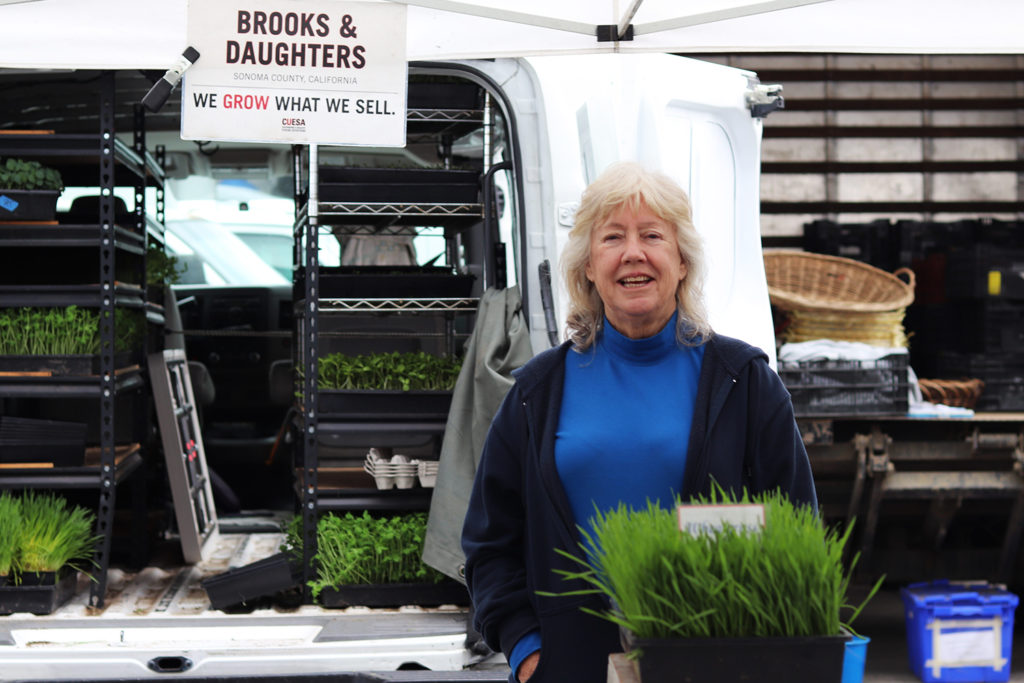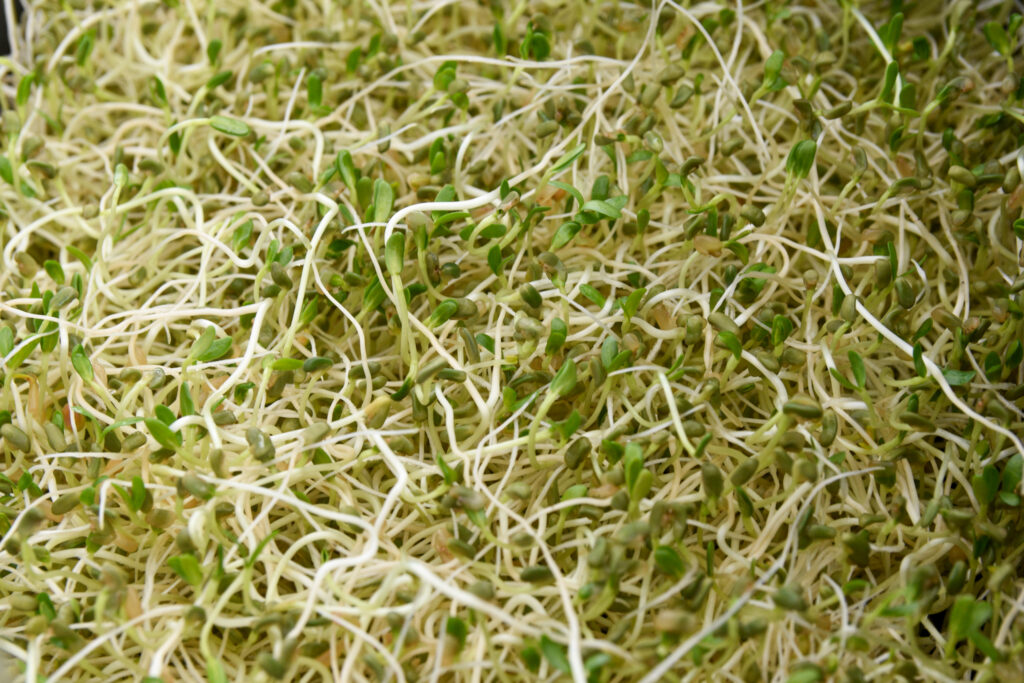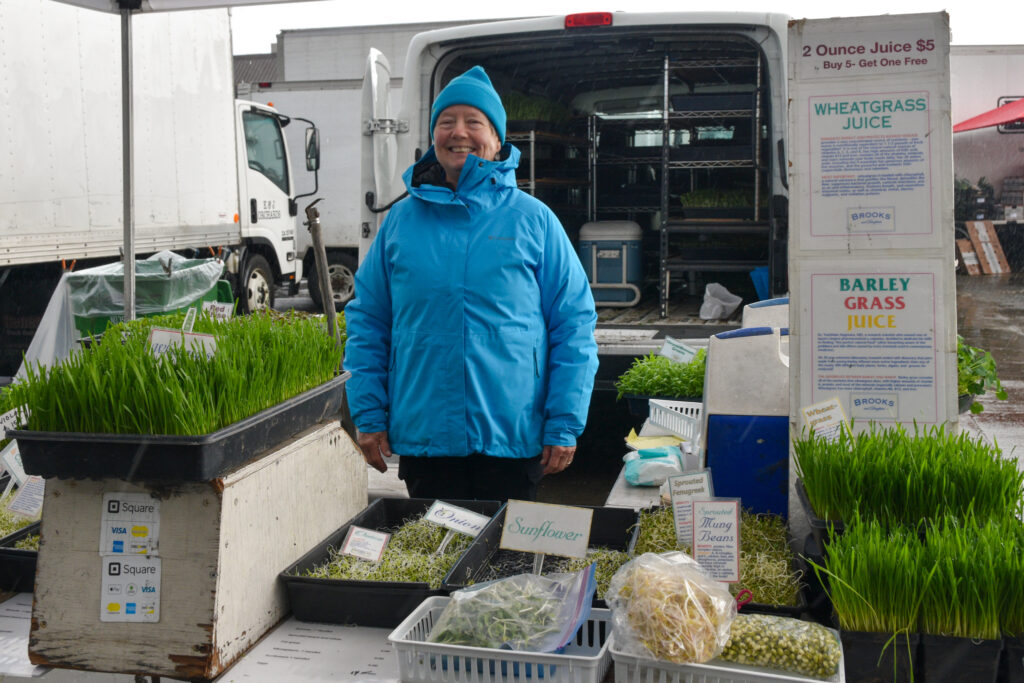The Raw Truth about Sprouts and Microgreens
Selina Knowles and Brie Mazurek, Foodwise Staff
January 26, 2024

If you’ve never considered yourself a sprout lover, Corie Brooks might just prove you wrong. “I think that people need to be educated on why sprouts and microgreens are good for them and what potential health benefits there are to eating something that’s so nutrient dense,” says Corie. From wheatgrass and bean sprouts to baby arugula and cilantro, she grows 40 varieties of sprouts and microgreens at Brooks and Daughters, her five-acre farm in Forestville.
A former food scientist, Corie has always been fascinated with sprouts and microgreens. In the 1990s, she transitioned from her corporate job to blaze a new trail by growing sprouts commercially. Not long after, Brooks and Daughters (named for Corie’s two daughters, Geneva and Lindsay) started selling at the Ferry Plaza Farmers Market, and almost 30 years later, they’ve gained a loyal following amongst local chefs and home cooks alike.

Magnifying the Differences Between Sprouts and Microgreens
For the uninitiated eater, sprouts and microgreens may all fall into one vague category of tiny plants, but there are some subtle but important differences to understand. Technically, sprouts are newly germinated seeds. They may exhibit their first tiny leaves, known as cotyledons, but (unlike microgreens) they are always harvested before they develop true leaves.
Grown in dark conditions without soil and fertilizers, the seeds are fed solely by water, air, and the nutrients from the seeds’ embryos. “It’s like raising baby chicks,” explains Corie. “At first, the food comes from the yolk.”
If sprouts are the infants of the produce world, microgreens are the youngsters. Whereas sprouts can reach their prime in just a few days, microgreens are grown for up to five weeks. And microgreens are cut off at the stem when purchased, instead of being sold roots and all, as sprouts are.
Microgreens must also be grown in a nutrient-rich substrate, which, at Brooks and Daughters, consists solely of homemade organic compost. Because their product is raised to be at its peak for each market, any unsold leftovers go to their chickens and guinea hens, which in turn contribute to their compost pile. “Everything goes around in a big circle,” says Corie.

Minding the Short Shelf Life of These Densely Nutritious Greens
Corie still does most of the growing, processing, and marketing herself. Helping eaters understand the ins and outs of growing, storing, and eating their product requires a bit of education, Corie notes. “People don’t always understand the benefits of what they’re eating.”
Devotees of sprouts attest to the benefits of eating certain grains, greens, and legumes in their immature state. Sprouted seeds and microgreens are often more nutrient-dense than ungerminated seeds or mature vegetables. “A lot of flavor, vitamins, and minerals that are going to be in the plant are concentrated in the sprouts,” Corie notes.
Corie also emphasizes that sprouts and microgreens also have a short shelf life. They are best eaten raw, as they lose their vitality, as well as precious water-soluble vitamins and enzymes, when cooked. The delicate greens should be stored in a dry, airtight container with a paper towel and always refrigerated. According to Corie, they’re best consumed within five days of purchase; when stored well, they can last for up to a week.
Like any living creature, these tiny plants require some special care, but they’re worth getting to know. As Corie says, “They’re alive and growing at the market, just waiting for people to take them home.”
You’ll find plenty of microgreens and sprouted nuts and seeds at their booth year round, but, because Corie prefers to keep the operation low-tech, some items are only available seasonally. Brooks and Daughters is also expanding their variety with offerings such as wheatgrass juice and edible flowers such as nasturtium and violas.

Chefs and Farmers Market Shoppers as Sprouts Ambassadors
Over the years, Brooks and Daughters has been a part of several farmers markets in the Bay Area, but reliable business at the Ferry Plaza Farmers Market meant they could slow down to just the one. Brooks and Daughters patrons’ may recognize Denise, Corie’s neighbor who often works at the farmers market stand.
Brooks and Daughters sells over 95 percent of their product directly to customers at the Ferry Plaza Farmers Market. Corie says about half of sales come from chefs of local restaurants and the other half comes from farmers market shoppers.
Local chefs are often ambassadors for some of the more niche harvests at the farmers market, and Corie says that chefs have definitely helped her sustain her business. She recalls days where Nopa chef Laurence Jossel would pick up flats of her sprouts and microgreens and place them on the top of his chef shopping cart as he went around the market.
“He would put the Shiso flats on his shopping cart, and then he would cruise through the market talking to everybody. Everybody would say, ‘What is that? Where did you get it?’ And he would send them to me,” says Corie. “I always say that he saved my business because I feel like he really made a huge impact.”
In addition to chefs, Corie is also grateful for regulars who have been visiting Brooks and Daughters at farmers markets for years. “We’ve had a number of customers who have been with us for years and years and years,” says Corie. “They come to San Francisco and tell us that the reason they come to the market is because we’re there, which is nice.”
You can find Brooks and Daughters at the Saturday market in the back plaza.
This article has been updated from a previously published version.
